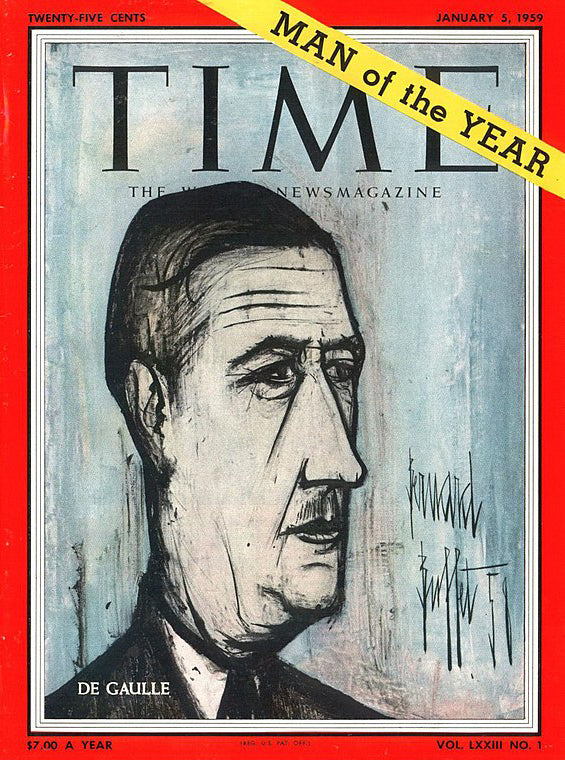The new franc: the story of a reform

On June 1, 1958, the French Fourth Republic was rapidly approaching its end.
General de Gaulle, supported by René Coty, was set to make his grand comeback.
The National Assembly granted him six months of absolute power, to be devoted, among other things, to laying the foundations for a major constitutional reform delivering the Fifth Republic.
Consequently, on January 8, 1959, Charles de Gaulle entered the Élysée Palace as President of France.
At the same time, weakened by the World Wars and inflation, the franc germinal had lost a great deal of its value and former magnificence, so it was time for it to pack its bags.
The new franc, also known by the name franc Pinay after the French Minister of Finance at the time, entered the scene on January 1, 1960.
The move was part of a major monetary restructuring plan launched in 1958, with 1 new franc being worth 100 old francs.
From a psychological perspective, the measure was not – at first – without impact, as the average salary dropped “virtually” from 61,000 (old) francs to 610 (new) francs. However, on the whole, people coped.
And, on the other hand, the franc stabilized again, and convertibility was simplified thanks to a fixed value of 180 milligrams of pure gold. By 1963, it had reached the value of the franc in 1913 again. France regained its place on the foreign exchange market and its prestige grew.
In an article dated December 18, 1959, the French newspaper Le Monde reported:
“Why this change and what will it change? The aim...was to provoke a psychological shock favorable to the franc. (...) In the eyes of international opinion, which is more sensitive to appearances than the underlying reality, the fact that the new French franc is worth around the same as the Swiss franc and just slightly less than the German mark will be considered a sign of financial health and economic strength. The old franc, well known for its periodic devaluations, will soon be forgotten.”
A new republic, so a new franc!
While the reform was established, the entering into circulation of the coins and banknotes took a more gradual course.
In practice, therefore, the old banknotes and coins continued to be used, but were only worth 1/100 of their original face value.
França 10 Nouveaux Francs on 1000 Francs
Richelieu, 1957, 1957-03-07
1 – Overprinted banknotes
In the second half of 1959, in preparation for the transition, the old franc banknotes were overprinted with their values in new francs.
The banknotes in questions were:
- The “Victor Hugo” 500 (old) franc banknotes
- The “Richelieu” 1,000 (old) franc banknotes
- The “Henry IV” 5,000 (old) franc banknotes
- The “Bonaparte” 10,000 (old) franc banknotes
In a second phase, the same banknotes were issued with only their value in new francs: 5, 10, 50, and 100 francs, respectively.
2 – The franc coins
The 1 and 5 (new) franc coins got the ball rolling. They were made of nickel and featured Oscar Roty’s famous semeuse (sower) on the obverse.
A reference to a period that those under the age of 20 may not know, but when the – now old – franc was prosperous.
More info about the coin above here
Minted in 1959 and dated 1960, these coins entered circulation on January 1:
| Denomination | Mint | Year | 1st issue |
|---|---|---|---|
| 1 franc | Paris | 1960 | 48,815,000 |
| 1 franc | Beaumont-le-Roger | 1960 | 13,505,000 |
| 5 francs | Paris | 1960 | 34,200,000 |
It is worth noting that none of them bears the words “nouveau franc” (new franc) but rather the value in francs.
Moeda França
Semeuse, 5 Francs, 1960, Monnaie de Paris, Piéfort, MS(65-70)
The 5 franc coin was smaller than its old franc equivalent and can also be distinguished by its edge, which bears the French national motto “Liberté, Égalité, Fraternité” (Liberty, Equality, Fraternity).
As for the 1 franc coin, for reference, it retained the same weight, size, and fluting of its old franc counterpart.
There were no real trials with the exception of adjustment strikes for the machines. Coins bearing the word “Essai” (trial) were actually issued for communication purposes. 4,000 copies of each were produced and distributed to members of parliament and senators in particular.
In contrast, the original project to introduce the “sower” 2 franc was not realized during the first years of the new franc, despite numerous attempts.
As for the “Hercules” 10 francs, it did not arrive until the battle of the transition from the old to the new franc was over in 1964.
França Set 1 ct.
2 cts. et 5 cts., Épi, 1961, MDP, ENSAIO, Aço Inoxidável
3 – The centimes
Due to the sheer volume of minting required, the centime coins were introduced very gradually.
The design of the 1 and 5 centime coins was based on the famous wheat ear centime and its very recognizable cursive script. A refined style on steel, coin strike, smooth edge, visually very identifiable and designed by Marcel Guilleminet.
As an anecdote, the hardness of the steel caused some coin accidents when they wore out: the worn coins developed a slight ledge under the right leaf of the wheat ear.
The 1 and 5 centime coins entered circulation successively:
| Denomination | Mint | Year | 1st issue |
|---|---|---|---|
| 5 centimes | Paris | 1961 | 39,000,000 |
| 1 centime | Paris | 1962 | 34,200,000 |
The 5 centime coin was quickly demonetized in 1966 and replaced by a “Marianne” type.
The small but sturdy 1 centime remained in circulation until 2001.
Although a 2 centime coin was originally planned, this remained in the project stage and never entered circulation. 3,500 examples bearing the word “Essai” (trial) were struck in 1961.
Moeda França
Marianne, 20 Centimes, 1962, Paris, VF(30-35), Alumínio-Bronze
The 10, 20, and 50 centime coins were of the “Marianne” type and made from a copper-aluminum-nickel alloy. The engraver was Henri Lagriffoul.
The coins entered circulation in 1962:
| Denomination | Mint | Year | 1st issue |
|---|---|---|---|
| 10 centimes | Paris | 1962 | 29,100,000 |
| 20 centimes | Paris | 1962 | 48,200,000 |
| 50 centimes | Paris | 1962 | 37,560,000 |
In 1963, the new franc is no more – vive le franc!
On January 1, 1963, on the occasion of the New Year address, the then Minister of Finance, a certain Valéry Giscard d’Estaing, announced that from that day forward the adjective “nouveau” (new) would no longer be attached to the franc, but the adjective “ancien” (old) would be appended to the franc germinal instead.
And so, in just four years, from the decree to the disappearance of the old franc and advent of the (now not so) new franc, the transition was completed, and France had a new currency.
The demonetization of the old franc then followed step by step.
And 40 years later, a new, large-scale monetary transition would take place... But that is another story...
Sources
- https://enseignants.lumni.fr/fiche-media/00000000356/le-nouveau-franc-succede-en-1960-au-franc-bonaparte.html
- https://www.monnaiedeparis.fr/en/shop/la-semeuse-le-nouveau-franc
- Magazine “Histoires & connaissances”, “La Ve République”, special issue, July 2021
- https://www.economie.gouv.fr/saef/antoine-pinay
- https://fr.wikipedia.org/wiki/Liste_des_%C3%A9missions_de_franc_fran%C3%A7ais_depuis_1960
- https://en.numista.com/catalogue/pieces1.html
- https://monnaie-magazine.com/1960-les-premieres-pieces-en-nouveau-franc/
- https://www.lemonde.fr/archives/article/1959/12/18/les-reponses-aux-questions-que-vous-vous-posez-concernant-le-le-nouveau-franc-qui-sera-mis-en-circulation-le-1er-janvier-19c0_3142117_1819218.html
- https://en.numista.com/catalogue/pieces689.html
- https://en.numista.com/catalogue/france-40.html
Iconography
- Déplacement du président de la République française Charles de Gaulle en Auvergne (5 au 7 juin 1959) : visite du site de Cataroux (Michelin) - Service des voyages officiels (ministère de l'Intérieur) CC4 Licence)
- Time magazine cover - Charles De Gaulle, Man of the Year - Jan. 5, 1959 (Public domain)


























